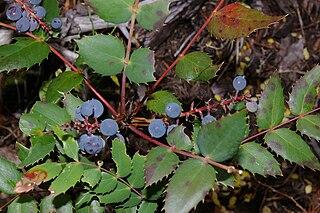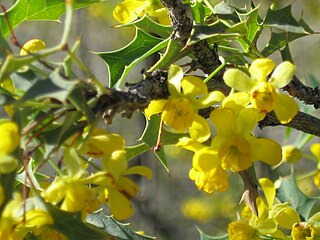
Mahonia aquifolium, the Oregon grape or holly-leaved barberry, is a species of flowering plant in the family Berberidaceae, native to western North America. It is an evergreen shrub growing 1 m (3 ft) to 3 m (10 ft) tall by 1.5 m (5 ft) wide, with pinnate leaves consisting of spiny leaflets, and dense clusters of yellow flowers in early spring, followed by dark bluish-black berries.

Mahonia is a genus of approximately 70 species of evergreen shrubs and, rarely, small trees in the family Berberidaceae, native to eastern Asia, the Himalaya, North and Central America. They are closely related to the genus Berberis and botanists disagree on whether to recognize a separate Mahonia. Many botanists prefer to classify Mahonia as a part of Berberis because several species in both genera are able to hybridize, and because there are no consistent morphological differences between the two groups other than the leaf pinnation. However, recent DNA-based phylogenetic studies retain the two separate genera, by clarifying that unifoliolate-leaved Berberis s.s. is derived from within a paraphyletic group of shrubs bearing imparipinnate evergreen leaves, which are then divided into three genera: Mahonia, Alloberberis, and Moranothamnus ; a broadly-circumscribed Berberis would also be monophyletic.

Berberis, commonly known as barberry, is a large genus of deciduous and evergreen shrubs from 1–5 m (3.3–16.4 ft) tall, found throughout temperate and subtropical regions of the world. Species diversity is greatest in South America and Asia; Europe, Africa and North America have native species as well. The best-known Berberis species is the European barberry, Berberis vulgaris, which is common in Europe, North Africa, the Middle East, and central Asia, and has been widely introduced in North America. Many of the species have spines on the shoots and all along the margins of the leaves.

Mahonia nervosa, commonly known as dwarf Oregon-grape, Cascade barberry, Cascade Oregon-grape, or dull Oregon-grape, is a flowering plant native to the northwest coast of North America from southern British Columbia south to central California, with an isolated population inland in northern Idaho. It is especially common in second growth, Douglas-fir or western redcedar forests, making use of those pools of sunlight that intermittently reach the ground.

Mahonia repens commonly known as creeping mahonia, creeping Oregon grape, creeping barberry, or prostrate barberry, is a species of Mahonia native to the Rocky Mountains and westward areas of North America, from British Columbia and Alberta in the north through Arizona and New Mexico, then into northwest Mexico by some reports. It is also found in many areas of California and the Great Basin region in Nevada.

Mahonia trifoliolata is a species of flowering plant in the family Berberidaceae, in southwestern North America. Common names include agarita, agrito, algerita, currant-of-Texas, wild currant, and chaparral berry. The name Agarita comes from the Spanish verb agarrar, which means "to grab". The ending "-ita" is often added to little things, so agarita means "grabs a little". This was probably said because the bush is a bit scratchy but does not have significant spines. Typical characteristics are grey-green to blue-grey leaves, yellow flowers in February to April and the red berries appearing in May. The most important harvest organ are the berries, though the roots and seeds can also be used.

Mahonia nevinii, known by the common name Nevin's barberry, is a species of flowering shrub in the barberry family.
Berberis piperiana is a shrub native to the mountains of northern California and southwestern Oregon. It is found in open and wooded slopes at elevations of 900–1,700 m (3,000–5,600 ft).
Berberis pimana is a species of the genus Berberis in the family Berberidaceae. It is native to a mountainous region of the Sierra Madre Occidental in the Mexican states of Chihuahua and Sonora.
Berberis moranensis is a shrub in the genus Berberis in the family Berberidaceae. Because of its compound leaves, some botanists place it in the genus Mahonia. It is native to forested regions of the mountains of Mexico from Sinaloa and Guanajuato to Oaxaca. Berberis moranensis has thick waxy leaves, yellow flowers, and purple berries. This species is closely related to Berberis pimanaJ.E. Laferr. & J.S. Marr.
Berberis chochoco is an evergreen shrub or small tree up to 9 m (30 ft) tall, in the genus Berberis, family Berberidaceae. It is native to mountainous regions of northeastern Mexico, in the states of Nuevo León, Veracruz, and San Luis Potosí.

Berberis harrisoniana is a rare species of flowering plant in the barberry family, Berberidaceae. It is known by the common names Kofa barberry, Kofa Mountain barberry, Harrison's barberry, and red barberry.
Berberis swaseyi is a rare species of barberry endemic to the Edwards Plateau region of Texas. It grows in limestone ridges and canyons. The species is evergreen, with thick, rigid, 5-9-foliolate leaves. Berries are dry or juicy, white to red, about 9–16 mm in diam.

Berberis haematocarpa, Woot. with the common names red barberry, red Mexican barbery, Colorado barberry and Mexican barberry, is a species in the Barberry family in southwestern North America. It is also sometimes called algerita, but that name is more often applied to its relative, Mahonia trifoliolata.
Berberis wilcoxii is a shrub native to Arizona, New Mexico and Sonora. It is up to 2 m tall, with pinnately compound leaves of 5-7 leaflets, densely clustered racemes and ovoid berries up to 10 mm long. It is generally found in rocky canyons in mountainous areas at an elevation of 1700–2500 m.
Berberis muelleri is a shrub with compound leaves, native to the Mexican State of Nuevo León.

Berberis higginsiae is a shrub found only in a small region south and east of San Diego in southern California and northern Baja California. It grows in chaparral and woodland areas at elevations of 800–1,200 m (2,600–3,900 ft).
Berberis pumila is a species of shrub native to Oregon and northern California. It is found in open woods and rocky areas at an altitude of 300–1,200 m (980–3,940 ft) in the Coast Ranges, the northern Sierra Nevada and the southern Cascades.
Joseph Edward Laferrière is an American botanist with a particular interest in ethnobotany.
Berberis standleyi is a shrub in the Berberidaceae described as a species in 1952. It was published with the name Mahonia glauca, a very different plant from Berberis glauca. Thus if one desires to consider Berberis and Mahonia as one genus instead of two, it is necessary to use a different name, i.e. Berberis standleyi.










